Integrated Flood Impact and Vulnerability Assessment Using a Multi-Sensor Earth Observation Mission with the Perspective of an Operational Service in Lombardy, Italy
Abstract
1. Introduction
2. Materials and Methods
2.1. Methodology Overview
2.2. Hazard EstimationDetection—Water Extent and Water Depth
2.3. Exposure Delineation
2.4. Vulnerability Assessment
2.4.1. Social Vulnerability Analysis
2.4.2. Probabilistic Approach to Physical Vulnerability
2.4.3. Integrated (Physical and Social) Impact
2.5. Study Case
2.5.1. Location and Flood History
2.5.2. Data Sources
3. Results
3.1. Hazard Detectiont
3.2. Exposure Delineation-Assets and Population
3.3. Vulnerability Assessment
3.3.1. Index for Social Vulnerability against Disasters
3.3.2. Probabilistic Approach to Physical Vulnerability
3.3.3. Social and Physical Integrated Impact
4. Discussion
4.1. Users’ Operational Needs Fulfillment
4.2. Hazard Detection and Exposure Delineation
4.3. Vulnerability Assessment
4.4. Flood Management and Emergency Implications
5. Conclusions
Author Contributions
Funding
Data Availability Statement
Conflicts of Interest
Appendix A
| Variable | Unit of Measurement | Range | Default Values | Input Values |
| Water depth outside the building (he) | m | ≥0 | [0;0.5] Incremental step: 0.01 | [0–5.5] Incremental step: 0.05 |
| Water depth inside the building (for each floor) (h) | m | [0;1H] | h = f(he, GL) | h = f(he, GL) |
| Max velocity of the water perpendicularly to the building (v) | m/s | ≥0 | 0.5 | 0.5 |
| Sediment load (s) | % on the water volume | [0;1] | 0.05 | 0.05 |
| Duration of the flood event (d) | hours | >0 | 24 | 36 |
| Water quality (presence of pollutants) (q) | - | 0: No 1: Yes | 1 | 1 |
Appendix B
| Variable | Unit of Measurement | Range | Default Values | Input Values |
| Footprint area (FA) | m2 | >0 | 100 | [12.6; 23,666.2] |
| Internal area (IA) | m2 | >0 | 0.9xFA | 0.9xFA |
| Basement area (BA) | m2 | ≥0 | 0.5xFA | 0.5xFA |
| External perimeter (EP) | m | >0 | 4xξ | [14.2; 2794.9] |
| Internal perimeter (IP) | m | >0 | 2.5 EP | 2.5 EP |
| Basement perimeter (BP) | m | >0 | 4xξ | 4xξ |
| Number of floors (NF) | - | ≥1 | 2 | [1; 4] |
| Interfloor height (IH) | m | >0 | 3.5 | 3.5 |
| Basement height (BH) | m | >0 | 3.2 | 3.2 |
| Ground floor level (GF) | m | [-IH; >0] | 0.1 | 0.1 |
| Basement level (BL) | m | <0 | -GL-BH-0.3 | -GL-BH-0.3 |
| Building type (BT) | - | 1: Detached house 2: Semi-detached house 3: Apartment house | 1 | [1; 2; 3] |
| Building structure (BS) | - | 1: Reinforced concrete 2: Masonry | 2 | [1; 2] |
| Finishing level (i.e., building quality) (FL) | - | 0.8: low 1: medium 1.2: high | 1.2 | 1.2 |
| Level of maintenance (LM) | - | 0.9: low 1: medium 1.1: high | 1.1 | [0.9; 1; 1.1] |
| Year of construction (YY) | - | ≥0 | 1994 | [1880; 2015] |
| Heating system distribution (PD) | - | 1: centralized 2: distributed | 1 if YY ≤ 1990 2 otherwise | 1 if YY ≤ 1990 2 otherwise |
| Heating system type (PT) | - | 1: radiator 2: pavement | 2 if YY ≥ 2000 and FL > 1 1 otherwise | 2 if YY ≥ 2000 and FL > 1 1 otherwise |
Appendix C

Appendix D
| Services | Requirement Description | Spatial Resolution | Temporal Frequency | SWAT | Spectral Band | Italian Legislation | EU Legislation |
| Water resource | Products to support hydrological and hydraulic modeling, flood forecasting, and sediment management | 1 m × 1 m | daily | Regional/ Local | NA | D. Lgs. 152/2006 e s.m.i. D. Lgs. 30/2009 D.M. MATTM 260/2010 D.D. MATTM 465/STA (2016) D.M. MATTM 86/2016 D.Lgs. 49/2010 | 2000/60/EC 2006/118/CE COM(2007) 414 final |
| Water resource | Products to support hydrological and hydraulic modeling, flood forecasting, and sediment management | 5 m × 5 m | monthly | NA | X | D. Lgs. 152/2006 e s.m.i. D. Lgs. 30/2009 D.M. MATTM 260/2010 D.D. MATTM 465/STA (2016) D.M. MATTM 86/2016 D.Lgs. 49/2010 | 2000/60/EC 2006/118/CE COM(2007) 414 final |
| Water resource | Products to support hydrological and hydraulic modeling, flood forecasting, and sediment management | 10 m × 10 m | daily | Regional | C/X | D. Lgs. 152/2006 e s.m.i. D. Lgs. 30/2009 D.M. MATTM 260/2010 D.D. MATTM 465/STA (2016) D.M. MATTM 86/2016 D.Lgs. 49/2010 | 2000/60/EC 2006/118/CE COM(2007) 414 final |
| Water resource | Hydromorphological characterization and monitoring of streams. Diachronic analysis of river courses and related water levels; evolution of the reticulum and its anatomization over time—ordinary if not in a flood emergency | 5 m × 5 m | monthly | NA | X | D. Lgs. 152/2006 e s.m.i. D. Lgs. 49/2010 D. Lgs 28/2011 D.M. MATTM 260/2010 D.M. MATTM (2004) D.Lgs 112/98 L. 132/2016 | 2000/60/EC 2007/60/EC 2009/28/EC |
| Water resource | Hydromorphological characterization and monitoring of streams. Diachronic analysis of river courses and related water levels; evolution of the reticulum and its anatomization over time—ordinary if not in a flood emergency | 1 m × 1 m | 15 days | Regional | X | ||
| Water resource | Hydromorphological characterization and monitoring of streams. Diachronic analysis of river courses and related water levels; evolution of the reticulum and its anatomization over time—ordinary if not in a flood emergency | 1 m × 1 m | trimester | Local | X | D. Lgs. 152/2006 e s.m.i. D. Lgs. 49/2010; D. Lgs 28/2011 D.M. MATTM 260/2010 D.M. MATTM (2004) D.Lgs 112/98; L. 132/2016 | 2000/60/EC 2007/60/EC 2009/28/EC |
| Water resource | Services to support identification of target species’ habitat and description of environmental status | <1 m | annual | Regional | C/X | ||
| Water resource | Sub-surface water leakage identification and monitoring; restoration-emergency monitoring | 10 m × 10 m | trimester | Local | L | Water Framework Directive (2000/60/EC) Bathing Water Directive (2006/7/EC) | |
| Water resource | Automatic changes in multi-temporal surface water levels; soil moisture trends for correlations with water balance—ordinary if not flood or drought phases | 1 m × 1 m | daily | Regional | L | D. Lgs. 152/2006 e s.m.i. D. Lgs. 30/2009 D.M. MATTM 260/2010 D.D. MATTM 465/STA (2016) D.M. MATTM 86/2016 D.M. MATTM (2004) | 2000/60/EC 2007/60/EC 2006/118/CE COM(2007) 414 final |
| Water resource | Drought Scenario Assessment by Emergent Status | 1 m × 1 m | daily | Regional | NA | D. Lgs. 152/2006 e s.m.i. D. Lgs. 30/2009 D.M. MATTM 260/2010 D.D. MATTM 465/STA (2016) D.M. MATTM 86/2015 | 2000/60/EC 2006/118/CE COM(2007) 414 final |
| Water resource | Drought Scenario Assessment by Emergent Status | 5 m × 20 m | daily | Regional | NA | D. Lgs. 152/2006 e s.m.i. D. Lgs. 30/2009 D.M. MATTM 260/2010 D.D. MATTM 465/STA (2016) D.M. MATTM 86/2015 | 2000/60/EC 2006/118/CE COM(2007) 414 final |
| Water resource | Drought Scenario Assessment by Emergent Status | 10 m × 10 m | weekly | Regional | NA | D. Lgs. 152/2006 e s.m.i. D. Lgs. 30/2009 D.M. MATTM 260/2010 D.D. MATTM 465/STA (2016) D.M. MATTM 86/2015 | 2000/60/EC 2006/118/CE COM(2007) 414 final |
| Emergency | Mapping the extent of flooding | 1 m × 1 m | daily | Local | X | ° D.Lgs. 139/2006 (artt. 1 e 24) ° DPR 64/2012 (artt.56, 63, 64,65) ° DM 29.1.2019 (Allegato 1) ° D. Lgs. N.1 del 2.1.2018 ° DPCM 20.2.2019 | Direttiva Alluvioni |
| Emergency | Mapping the extent of flooding | 1 m × 1 m | daily | NA | C/X | ° D.Lgs. 139/2006 (artt. 1 e 24) ° DPR 64/2012 (artt.56, 63, 64,65) ° DM 29.1.2019 (Allegato 1) ° D. Lgs. N.1 del 2.1.2018 ° DPCM 20.2.2019 (Azione 20) ° Accordo quadro CNVVFASI ° Circolare DIPVVF n.1/2011 | |
| Emergency | Mapping the extent of flooding | 10 m × 10 m | daily | Local | C/X | ° D.Lgs. 139/2006 (artt. 1 e 24) ° DPR 64/2012 (artt.56, 63, 64,65) ° DM 29.1.2019 (Allegato 1) ° D. Lgs. N.1 del 2.1.2018 (Codice di Protezione Civile Artt. 10, 17, 18, 21) ° DPCM 20.2.2019 (Azione 20) ° Accordo quadro CNVVFASI ° Circolare DIPVVF n.1/2011 | |
| Emergency | Monitoring of flood level over time from SAR data compared with a “0” level referenced to the digital terrain model | <1 m | daily | Local | X | ° D.Lgs. 139/2006 (artt. 1 e 24) ° DPR 64/2012 (artt.56, 63, 64,65) ° DM 29.1.2019 (Allegato 1) ° D. Lgs. N.1 del 2.1.2018 ° DPCM 20.2.2019 (Azione 20) ° Accordo quadro CNVVF-ASI ° Circolare DIPVVF n.1/2011 | |
| Emergency | Monitoring of flood level over time from SAR data compared with a “0” level referenced to the digital terrain model | 1 m × 1 m | daily | NA | X | ° D.Lgs. 139/2006 (artt. 1 e 24) ° DPR 64/2012 (artt.56, 63, 64,65) ° DM 29.1.2019 (Allegato 1) ° D. Lgs. N.1 del 2.1.2018 ° DPCM 20.2.2019 (Azione 20) ° Accordo quadro CNVVF-ASI ° Circolare DIPVVF n.1/2011 |
References
- EM-DAT, the International Disaster Database. CRED/UCLouvain. Available online: https://emdat.be/frontpage (accessed on 6 June 2023).
- Ardaya, A.B.; Evers, M.; Ribbe, L. What influences disaster risk perception? Intervention measures, flood and landslide risk perception of the population living in flood risk areas in Rio de Janeiro state, Brazil. Int. J. Disaster Risk Reduct. 2017, 25, 227–237. [Google Scholar] [CrossRef]
- Scott, M.; White, I.; Kuhlicke, C.; Steinführer, A.; Sultana, P.; Thompson, P.; Minnery, J.; O’Neill, E.; Cooper, J.; Adamson, M.; et al. Living with flood risk/The more we know, the more we know we don’t know: Reflections on a decade of planning, flood risk management and false precision/Searching for resilience or building social capacities for flood risks?/Participatory floodplain management: Lessons from Bangladesh/Planning and retrofitting for floods: Insights from Australia/Neighbourhood design considerations in flood risk management/Flood risk management—Challenges to the effective implementation of a paradigm shift. Plan. Theory Pract. 2013, 14, 103–140. [Google Scholar] [CrossRef]
- Wang, Y. Advances in Remote Sensing of Flooding. Water 2015, 7, 6404–6410. [Google Scholar] [CrossRef]
- Birkmann, J. Risk and vulnerability indicators at different scales: Applicability, usefulness and policy implications. Environ. Hazards 2007, 7, 20–31. [Google Scholar] [CrossRef]
- Shitangsu, P. Vulnerability concepts and its applications in various fields: A review on geographical perspective. J. Life Earth Sci. 2013, 8, 63–81. [Google Scholar] [CrossRef]
- Natenzon, C.; Marlenko, N.; González, S.; Ríos, R.; Barrenechea, J.; Murgida, A.; Boudin, M.; Ludueña, S.; Gentile, E. Vulnerabilidad Social Estructural. In El Cambio Climático en el Río de la Plata; Barros, V., Menéndez y, A., Nagy, G., Eds.; CIMA: Buenos Aires, Argentina, 2005; pp. 121–130. [Google Scholar]
- González, S. Ciudad Visible vs. Ciudad Invisible. Gestión Urbana y Manejo de las Inundaciones en la Baja Cuenca del Arroyo Maldonado. Ph.D. Thesis, Phylosophy and Literature School, University of Buenos Aires, Buenos Aires, Argentina, 2009; 507p. [Google Scholar]
- Birkmann, J.; Cardona, O.D.; Carreño, M.L.; Barbat, A.H.; Pelling, M.; Schneiderbauer, S.; Kienberger, S.; Keiler, M.; Alexander, D.; Zeil, P.; et al. Framing vulnerability, risk and societal responses: The MOVE framework. Nat. Hazards 2013, 67, 193–211. [Google Scholar] [CrossRef]
- Malgwi, M.; Bawa, S.F.; Keiler, M. A generic physical vulnerability model for floods: Review and concept for data-scarce regions. Nat. Hazards Earth Syst. Sci. 2020, 20, 2067–2090. [Google Scholar] [CrossRef]
- Nofal, O.M.; van de Lindt, J.W.; Do, T.Q. Multi-variate and single-variable flood fragility and loss approaches for buildings. Reliab. Eng. Syst. Saf. 2020, 202, 106971. [Google Scholar] [CrossRef]
- Thapa, S.; Shrestha, A.; Lamichhane, S.; Adhikari, R.; Gautam, D. Catchment-scale flood hazard mapping and flood vulnerability analysis of residential buildings: The case of Khando River in eastern Nepal. J. Hydrol. Reg. Stud. 2020, 30, 100704. [Google Scholar] [CrossRef]
- Schröter, K.; Kreibich, H.; Vogel, K.; Riggelsen, C.; Scherbaum, F.; Merz, B. How useful are complex flood damage models? Water Resour. Res. 2014, 50, 3378–3395. [Google Scholar] [CrossRef]
- Wyncoll, D.; Gouldby, B. Integrating a multivariate extreme value method within a system flood risk analysis model. J. Flood Risk Manag. 2013, 8, 145–160. [Google Scholar] [CrossRef]
- Papathoma-Köhle, M.; Kappes, M.; Keiler, M.; Glade, T. Physical vulnerability assessment for alpine hazards: State of the art and future needs. Nat. Hazards 2011, 58, 645–680. [Google Scholar] [CrossRef]
- Zhang, S.; Zhang, L.; Li, X.; Xu, Q. Physical vulnerability models for assessing building damage by debris flows. Eng. Geol. 2018, 247, 145–158. [Google Scholar] [CrossRef]
- Englhardt, J.; de Moel, H.; Huyck, C.K.; de Ruiter, M.C.; Aerts, J.C.; Ward, P.J. Enhancement of large-scale flood risk assessments using building-material-based vulnerability curves for an object-based approach in urban and rural areas. Nat. Hazards Earth Syst. Sci. 2019, 19, 1703–1722. [Google Scholar] [CrossRef]
- Chan, N.; Parker, D.J. Response to dynamic flood hazard factors in peninsular Malaysia. Geogr. J. 1996, 162, 313–325. [Google Scholar] [CrossRef]
- Steinführer, A.; Kuhlicke, C. Social Vulnerability and the 2002 Flood: Country Report Germany (Mulde River). FLOOD Site Report T11-07-08, 2007. Available online: https://repository.tudelft.nl/islandora/object/uuid:c6ba6a90-13aa-488b-a5b3-efd7c816251a?collection=research (accessed on 31 May 2023).
- Brouwer, R.; Akter, S.; Brander, L.; Haque, E. Socioeconomic vulnerability and adaptation to environmental risk: A case study of climate change and flooding in Bangladesh. Risk Anal. 2007, 27, 313–326. [Google Scholar] [CrossRef]
- Ajibade, I.; McBean, G.; Bezner-Kerr, R. Urban flooding in Lagos, Nigeria: Patterns of vulnerability and resilience among women. Glob. Environ. Chang. 2013, 23, 1714–1725. [Google Scholar] [CrossRef]
- Greiving, S.; Fleischhauer, M.; Lückenkötter, J. A methodology for an integrated risk assessment of spatially relevant hazards. J. Environ. Plan. Manag. 2007, 49, 1–19. [Google Scholar] [CrossRef]
- Flanagan, B.E.; Gregory, E.W.; Hallisey, E.J.; Heitgerd, J.L.; Lewis, B. A Social Vulnerability Index for Disaster Management. J. Homel. Secur. Emerg. Manag. 2011, 8, 0000102202154773551792. [Google Scholar] [CrossRef]
- Rufat, S.; Tate, E.; Emrich, C.T.; Antolini, F. How valid are social vulnerability models? Ann. Am. Assoc. Geogr. 2019, 109, 1131–1153. [Google Scholar] [CrossRef]
- Tate, E. Uncertainty analysis for a social vulnerability index. Ann. Am. Assoc. Geogr. 2012, 103, 526–543. [Google Scholar] [CrossRef]
- Taramelli, A.; Valentini, E.; Sterlacchini, S. A GIS-based approach for hurricane hazard and vulnerability assessment in the Cayman Islands. Ocean Coast. Manag. 2015, 108, 116–130. [Google Scholar] [CrossRef]
- Taramelli, A.; Righini, M.; Valentini, E.; Alfieri, L.; Gatti, I.; Gabellani, S. Building-scale flood loss estimation through enhanced vulnerability pattern characterization: Application to an urban flood in Milano, Italy. Nat. Hazards Earth Syst. Sci. 2022, 22, 3543–3569. [Google Scholar] [CrossRef]
- Cutter, S.L.; Boruff, B.J.; Shirley, W.L. Social vulnerability to environmental hazards. Soc. Sci. Q. 2003, 84, 242–261. [Google Scholar] [CrossRef]
- Fekete, A.; Damm, M.; Birkmann, J. Scales as a challenge for vulnerability assessment. Nat. Hazards 2010, 55, 729–747. [Google Scholar] [CrossRef]
- Boruff, B.J.; Emrich, C.; Cutter, S.L. Erosion hazard vulnerability of US coastal counties. J. Coast. Res. 2005, 21, 932–942. [Google Scholar] [CrossRef]
- Chakraborty, J.; Tobin, G.A.; Montz, B.E. Population evacuation: Assessing spatial variability in geophysical risk and social vulnerability to natural hazards. Nat. Hazards Rev. 2005, 6, 23–33. [Google Scholar] [CrossRef]
- Coulibaly, M. Spatial analysis of an urban flash flood survey results. Geocarto Int. 2008, 23, 217–234. [Google Scholar] [CrossRef]
- Klemas, V. Remote sensing of floods and flood-prone areas: An overview. J. Coast. Res. 2015, 31, 1005–1013. [Google Scholar] [CrossRef]
- Mustafa, D. Structural causes of vulnerability to flood hazard in Pakistan. Econ. Geogr. 1998, 74, 289–305. [Google Scholar] [CrossRef]
- Cian, F.; Giupponi, C.; Marconcini, M. Integration of earth observation and census data for mapping a multi-temporal flood vulnerability index: A case study on Northeast Italy. Nat. Hazards 2021, 106, 2163–2184. [Google Scholar] [CrossRef]
- Taramelli, A.; Valentini, E.; Righini, M.; Filipponi, F.; Geraldini, S.; Nguyen Xuan, A. Assessing Po River Deltaic Vulnerability Using Earth Observation and a Bayesian Belief Network Model. Water 2020, 12, 2830. [Google Scholar] [CrossRef]
- Morelli, A.; Taramelli, A.; Bozzeda, F.; Valentini, E.; Colangelo, M.A.; Cueto, Y.R. The disaster resilience assessment of coastal areas: A method for improving the stakeholders’ participation. Ocean Coast. Manag. 2021, 214, 105867. [Google Scholar] [CrossRef]
- Pedersen, J.P.; Seljelv, L.G.; Bauna, T.; Strøm, G.D.; Follum, O.A.; Andersen, J.H.; Wahl, T.; Skøelv, Å. Towards an operational oil spill detection service in the Mediterranean? The Norwegian experience: A pre-operational early warning detection service using ERS SAR data. Spill Sci. Technol. Bull. 1996, 3, 41–46. [Google Scholar] [CrossRef]
- Schiavon, E.; Taramelli, A.; Tornato, A.; Pierangeli, F. Monitoring environmental and climate goals for European agriculture: User perspectives on the optimization of the Copernicus evolution offer. J. Environ. Manag. 2021, 296, 113121. [Google Scholar] [CrossRef]
- Pierdicca, N.; Chini, M.; Pulvirenti, L.; Macina, F. Integrating physical and topographic information into a fuzzy scheme to map flooded area by SAR. Sensors 2008, 8, 4151–4164. [Google Scholar] [CrossRef]
- Milillo, P.; Shanker, A.P.; Pascale, S.; Serio, C.; Sdao, F. Persistent scatterer interferometry based on COSMO-SkyMed imagery. In Proceedings of the 33rd EARSeL Symposium Towards Horizon 2020: Earth Observation and Social Perspectives, Matera, Italy, 3–6 June 2013; pp. 187–194. [Google Scholar]
- Giglio, E.; Dejana, M.; Bevilacqua, M. NOCTUA: Potenzialità innovative per l’Osservazione della Terra. In GEOMEDIA; GEOmedia: San Antonio, TX, USA, 2021; Volume 4, pp. 18–23. [Google Scholar]
- Conti, F.; Eugeni, M.; Bove, M.; Marzioli, P.; Marini, L.; Pasquali, M.; Schiavon, E.; Nguyen Xue, A.; Tornato, A.; Geraldini, S.; et al. A Model-based approach for the preliminary design of the SAR Upstream element for the Italian IRIDE EO constellation based on users’ demand. Adv. Space Res. 2023, accepted. [Google Scholar]
- Martinis, S.; Twele, A.; Voigt, S. Towards Operational near Real-Time Flood Detection Using a Split-Based Automatic Thresholding Procedure on High Resolution TerraSAR-X data. Nat. Hazards Earth Syst. Sci. 2009, 9, 303–314. [Google Scholar] [CrossRef]
- Mason, D.; Davenport, I.; Neal, J.; Schumann, G.; Bates, P. Near Real-Time Flood Detection in Urban and Rural Areas Using High-Resolution Synthetic Aperture Radar Images. Geoscience and Remote Sensing. IEEE Trans. Geosci. Remote Sens. 2012, 50, 3041–3052. [Google Scholar] [CrossRef]
- Cohen, J.; Riihimäki, H.; Pulliainen, J.; Lemmetyinen, J.; Heilimo, J. Implications of boreal forest stand characteristics for X-band SAR flood mapping accuracy. Remote Sens. Environ. 2016, 186, 47–63. [Google Scholar] [CrossRef]
- Pulvirenti, L.; Squicciarino, G.; Fiori, E.; Ferraris, L.; Puca, S. A Tool for Pre-Operational Daily Mapping of Floods and Permanent Water Using Sentinel-1 Data. Remote Sens. 2021, 13, 1342. [Google Scholar] [CrossRef]
- Geraldini, S.; Bruschi, A.; Bellotti, G.; Taramelli, A. User Needs Analysis for the Definition of Operational Coastal Services. Water 2021, 13, 92. [Google Scholar] [CrossRef]
- Taramelli, A.; Valentini, E.; Piedelobo, L.; Righini, M.; Cappucci, S. Assessment of State Transition Dynamics of Coastal Wetlands in Northern Venice Lagoon, Italy. Sustainability 2021, 13, 4102. [Google Scholar] [CrossRef]
- Wania, A.; Joubert-Boitat, I.; Dottori, F.; Kalas, M.; Salamon, P. Increasing Timeliness of Satellite-Based Flood Mapping Using Early Warning Systems in the Copernicus Emergency Management Service. Remote Sens. 2021, 13, 2114. [Google Scholar] [CrossRef]
- Matgen, P.; Hostache, R.; Schumann, G.; Pfister, L.; Hoffmann, L.; Savenije, H.H.G. Towards an automated SAR-based flood monitoring system: Lessons learned from two case studies. Phys. Chem. Earth Parts A/B/C 2011, 36, 241–252. [Google Scholar] [CrossRef]
- Henry, J.; Chastanet, P.; Fellahand, K.; Desnos, Y.-L. Envisat multipolarized ASAR for flood mapping. Int. J. Remote Sens. 2006, 27, 1921–1929. [Google Scholar] [CrossRef]
- Kang, H.; Kim, Y. The physical vulnerability of different types of building structure to debris flow events. Nat. Hazards 2016, 80, 1475–1493. [Google Scholar] [CrossRef]
- Climent-Gil, E.; Aledo, A.; Vallejos-Romero, A. The social vulnerability approach for social impact assessment. Environ. Impact Assess. Rev. 2018, 73, 70–79. [Google Scholar] [CrossRef]
- Wang, Y.; Colby, J.D.; Mulcahy, K.A. An efficient method for mapping flood extent in a coastal flood plain using Landsat TM and DEM data. Int. J. Remote Sens. 2002, 23, 3681–3696. [Google Scholar] [CrossRef]
- Lee, J.S. Digital image enhancement and noise filtering by use of local statistics. IEEE Trans. Pattern Anal. Mach. Intell. 1980, PAMI-2, 165–168. [Google Scholar] [CrossRef]
- Lee, J.S. Digital image smoothing and the sigma filter. Comput. Vis. Graph. Image Process. 1983, 24, 255–269. [Google Scholar] [CrossRef]
- Yang, L.; Driscol, J.; Sarigai, S.; Wu, Q.; Lippitt, C.D.; Morgan, M. Towards Synoptic Water Monitoring Systems: A Review of AI Methods for Automating Water Body Detection and Water Quality Monitoring Using Remote Sensing. Sensors 2022, 22, 2416. [Google Scholar] [CrossRef]
- Sebastianelli, A.; Del Rosso, M.P.; Ullo, S.L.; Gamba, P. A speckle filter for Sentinel-1 SAR ground range detected data based on residual convolutional neural networks. IEEE J. Sel. Top. Appl. Earth Obs. Remote Sens. 2021, 15, 5086–5101. [Google Scholar] [CrossRef]
- Shaikh, M.A.; Khiradeb, P.W.; Sayyada, S.B. Speckle Noise Filtering of Microwave X-Band High Resolution Spotlight Mode TerraSAR-X SAR Image. Bionano Front. 2015, 8, 2320–9593. [Google Scholar]
- Chini, M.; Hostache, R.; Giustarini, L.; Matgen, P. A hierarchical split-based approach for parametric thresholding of SAR images: Flood inundation as a test case. IEEE Trans. Geosci. Remote Sens. 2017, 55, 6975–6988. [Google Scholar] [CrossRef]
- Milczarek, M.; Robak, A.; Gadawska, A. Sentinel Water Mask (SWM)-new index for water detection on Sentinel-2 images. In Proceedings of the 7th Advanced Training Course on Land Remote Sensing, Gödöllo, Hungary, 4–9 September 2017. [Google Scholar]
- Cohen, S.; Brakenridge, G.R.; Kettner, A.; Bates, B.; Nelson, J.; McDonald, R.; Huang, Y.-F.; Munasinghe, D.; Zhang, J. Estimating Floodwater Depths from Flood Inundation Maps and Topography. J. Am. Water Resour. Assoc. 2018, 54, 847–858. [Google Scholar] [CrossRef]
- Cohen, S.; Raney, A.; Munasinghe, D.; Loftis, J.D.; Molthan, A.; Bell, J.; Rogers, L.; Galantowicz, J.; Brakenridge, G.R.; Kettner, A.J.; et al. The Floodwater Depth Estimation Tool (FwDET v2.0) for improved remote sensing analysis of coastal flooding. Nat. Hazards Earth Syst. Sci. 2019, 19, 2053–2065. [Google Scholar] [CrossRef]
- Peter, B.; Cohen, S.; Lucey, R.; Munasinghe, D.; Raney, A. A Google Earth Engine implementation of the Floodwater Depth Estimation Tool (FwDET-GEE). Harv. Dataverse 2020, V5. [Google Scholar] [CrossRef]
- Few, R. Flooding, vulnerability and coping strategies: Local responses to a global threat. Prog. Dev. Stud. 2003, 3, 43–58. [Google Scholar] [CrossRef]
- Saaty, T.L.; Vargas, L.G. Hierarchical analysis of behavior in competition: Prediction in chess. Syst. Res. Behav. Sci. 1980, 25, 180–191. [Google Scholar] [CrossRef]
- SAYDS. Social Vulnerability, Hazards and Risks Social Vulnerability. In Third National Communication from Argentinian Republic to the United Nations Framework Convention on Climate Change Project, Component 2; Centro de Investigaciones del Mar y la Atmósfera: Buenos Aires, Argentina, 2015. [Google Scholar]
- Merz, B.; Kreibich, H.; Schwarze, R.; Thieken, A. Review article “Assessment of economic flood damage”. Nat. Hazards Earth Syst. Sci. 2010, 10, 1697–1724. [Google Scholar] [CrossRef]
- Arosio, M.; Martina, M.L.; Creaco, E.; Figueiredo, R. Indirect Impact Assessment of Pluvial Flooding in Urban Areas Using a Graph-Based Approach: The Mexico City Case Study. Water 2020, 12, 1753. [Google Scholar] [CrossRef]
- Dottori, F.; Figueiredo, R.; Martina, M.L.V.; Molinari, D.; Scorzini, A.R. INSYDE: A synthetic, probabilistic flood damage model based on explicit cost analysis. Nat. Hazards Earth Syst. Sci. 2016, 16, 2577–2591. [Google Scholar] [CrossRef]
- Brouwer, R.; Van Ek, R. Integrated ecological, economic and social impact assessment of alternative flood control policies in the Netherlands. Eco. Econ. 2004, 50, 1–21. [Google Scholar] [CrossRef]
- Di Mauro, M.; De Bruijn, K.M.; Meloni, M. Quantitative methods for estimating flood fatalities: Towards the introduction of loss-of-life estimation in the assessment of flood risk. Nat. Hazards 2012, 63, 1083–1113. [Google Scholar] [CrossRef]
- Burton, C.G.; Silva, V. Integrated risk modelling within the Global Earthquake Model (GEM): Test case application for Portugal. In Proceedings of the Second European Conference on Earthquake Engineering and Seismology, Istanbul, Turkey, 24–29 August 2014; Volume 2529. 10p. [Google Scholar]
- Minotulo, A.; Zampetti, G. Ecosistema Rischio. Monitoraggio sulle Attività delle Amministrazioni Comunali per la Mitigazione del Rischio Idrogeologico; LegAmbiente: Roma, Italy, 2017; pp. 24–25. [Google Scholar]
- AVI Project—Consiglio Nazionale delle Ricerche. Available online: http://avi.gndci.cnr.it/ (accessed on 6 June 2022).
- ARPA Lombardy. Available online: https://www.arpalombardia.it/Pages/ARPA_Home_Page.aspx (accessed on 17 June 2022).
- RASDA—Raccolta Schede Danni—Lombardy Region. Available online: https://www.regione.lombardia.it/wps/portal/istituzionale/HP/DettaglioServizio/servizi-e-informazioni/Enti-e-Operatori/protezione-civile/rasda-raccolta-schede-danni/rasda-raccolta-schede-danni (accessed on 12 August 2022).
- Geoportale Regione Lombardia. Available online: https://www.geoportale.regione.lombardia.it/home (accessed on 15 June 2022).
- Geofabrik, Open Street Maps. Available online: https://www.geofabrik.de/data/ (accessed on 15 June 2022).
- Copernicus Land Monitoring Service. Available online: https://land.copernicus.eu/pan-european/corine-land-cover/clc2018 (accessed on 20 April 2023).
- ISTAT. Istituto Nazionale di Statistica. Available online: https://www.istat.it/it/archivio/104317 (accessed on 10 May 2022).
- Bigi, V.; Comino, E.; Fontana, M.; Pezzoli, A.; Rosso, M. Flood vulnerability analysis in urban context: A socioeconomic sub-indicators overview. Climate 2021, 9, 12. [Google Scholar] [CrossRef]
- Twele, A.; Cao, W.; Plank, S.; Martinis, S. Sentinel-1-based flood mapping: A fully automated processing chain. Int. J. Remote Sens. 2016, 37, 2990–3004. [Google Scholar] [CrossRef]
- Clement, M.; Kilsby, C.; Moore, P. Multi-temporal synthetic aperture radar flood mapping using change detection. J. Flood Risk Manag. 2017, 11, 152–168. [Google Scholar] [CrossRef]
- Tanguy, M.; Chokmani, K.; Bernier, M.; Poulin, J.; Raymond, S. River flood mapping in urban areas combining Radarsat-2 data and flood return period data. Remote Sens. Environ. 2017, 198, 442–459. [Google Scholar] [CrossRef]
- Armaş, I.; Gavriş, A. Census-based social vulnerability assessment for Bucharest. Procedia Environ. Sci. 2016, 32, 138–146. [Google Scholar] [CrossRef]
- Alizadeh, M.; Alizadeh, E.; Asadollahpour Kotenaee, S.; Shahabi, H.; Beiranvand Pour, A.; Panahi, M.; Baharin, B.B.; Saro, L. Social vulnerability assessment using artificial neural network (ANN) model for earthquake hazard in Tabriz city, Iran. Sustainability 2018, 10, 3376. [Google Scholar] [CrossRef]
- Loyola Hummell, B.M.; Cutter, S.L.; Emrich, C.T. Social vulnerability to natural hazards in Brazil. Int. J. Disaster Risk Sci. 2016, 7, 111–122. [Google Scholar] [CrossRef]
- Carbonneau, P.E.; Belletti, B.; Micotti, M.; Lastoria, B.; Casaioli, M.; Mariani, S.; Marchetti, G.; Bizzi, S. UAV-based training for fully fuzzy classification of Sentinel-2 fluvial scenes. Earth Surf. Process. Landf. 2020, 45, 3120–3140. [Google Scholar] [CrossRef]
- Marchetti, G.; Bizzi, S.; Belletti, B.; Lastoria, B.; Comiti, F.; Carbonneau, P.E. Mapping riverbed sediment size from Sentinel-2 satellite data. Earth Surf. Process. Landf. 2022, 47, 2544–2559. [Google Scholar] [CrossRef]
- WHO (World Health Organization). WHO Guidelines for Indoor Air Quality: Dampness and Mould; Druckpartner Mose: Copenhagen, Denmark, 2009; 248p. [Google Scholar]
- Yoon, S.K.; Kim, J.S.; Moon, Y.I. Integrated flood risk analysis in a changing climate: A case study from the Korean Han River Basin. KSCE J. Civ. Eng. 2014, 18, 1563–1571. [Google Scholar] [CrossRef]
- Molinari, D.; Scorzini, A.R.; Arrighi, C.; Carisi, F.; Castelli, F.; Domeneghetti, A.; Gallazzi, A.; Galliani, M.; Grelot, F.; Kellermann, P.; et al. Are flood damage models converging to “reality”? Lessons learnt from a blind test. Nat. Hazards Earth Syst. Sci. 2020, 20, 2997–3017. [Google Scholar] [CrossRef]
- Cardona, O.D.; Van Aalst, M.K.; Birkmann, J.; Fordham, M.; Mc Gregor, G.; Rosa, P.; Pulwarty, R.S.; Schipper, E.L.F.; Sinh, B.T.; Décamps, H.; et al. Determinants of risk: Exposure and vulnerability. In Managing the Risks of Extreme Events and Disasters to Advance Climate Change Adaptation: Special Report of the Intergovernmental Panel on Climate Change; Cambridge University Press: Cambridge, UK, 2012; Volume 9781107025066, pp. 65–108. [Google Scholar] [CrossRef]
- Albrecht, F. Natural hazard events and social capital: The social impact of natural disasters. Disasters 2018, 42, 336–360. [Google Scholar] [CrossRef]
- Brown, J.D.; Damery, S.L. Managing flood risk in the UK: Towards an integration of social and technical perspectives. Trans. Inst. Br. Geogr. 2002, 27, 412–426. [Google Scholar] [CrossRef]
- Gatti, I.; Martin, P.B.; Vargas, E.C.; Gasparotto, M.; Prario, B.E.; Gentile, E.E.; Patané, L.G. An Assessment of Severe Storms, Their Impacts and Social Vulnerability in Coastal Areas: A Case Study of General Pueyrredon, Argentina. In Applied Geomorphology and Contemporary Issues; Mandal, S., Maiti, R., Nones, M., Beckedahl, H.R., Eds.; Geography of the Physical Environment; Springer: Cham, Switzerland, 2022. [Google Scholar] [CrossRef]
- Mesta, C.; Cremen, G.; Galasso, C. Quantifying the potential benefits of risk-mitigation strategies on future flood losses in Kathmandu Valley, Nepal. Nat. Hazards Earth Syst. Sci. 2023, 23, 711–731. [Google Scholar] [CrossRef]
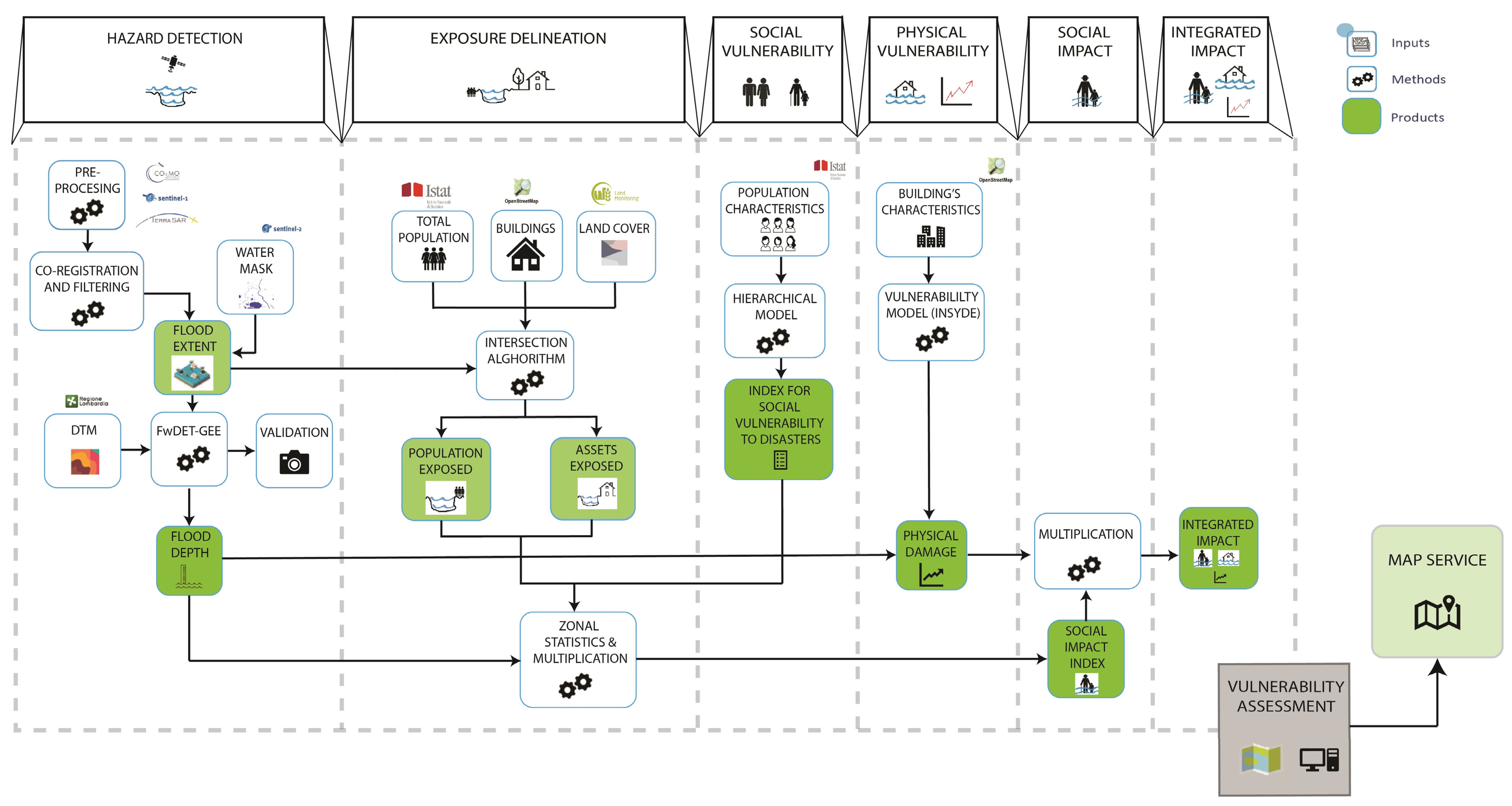
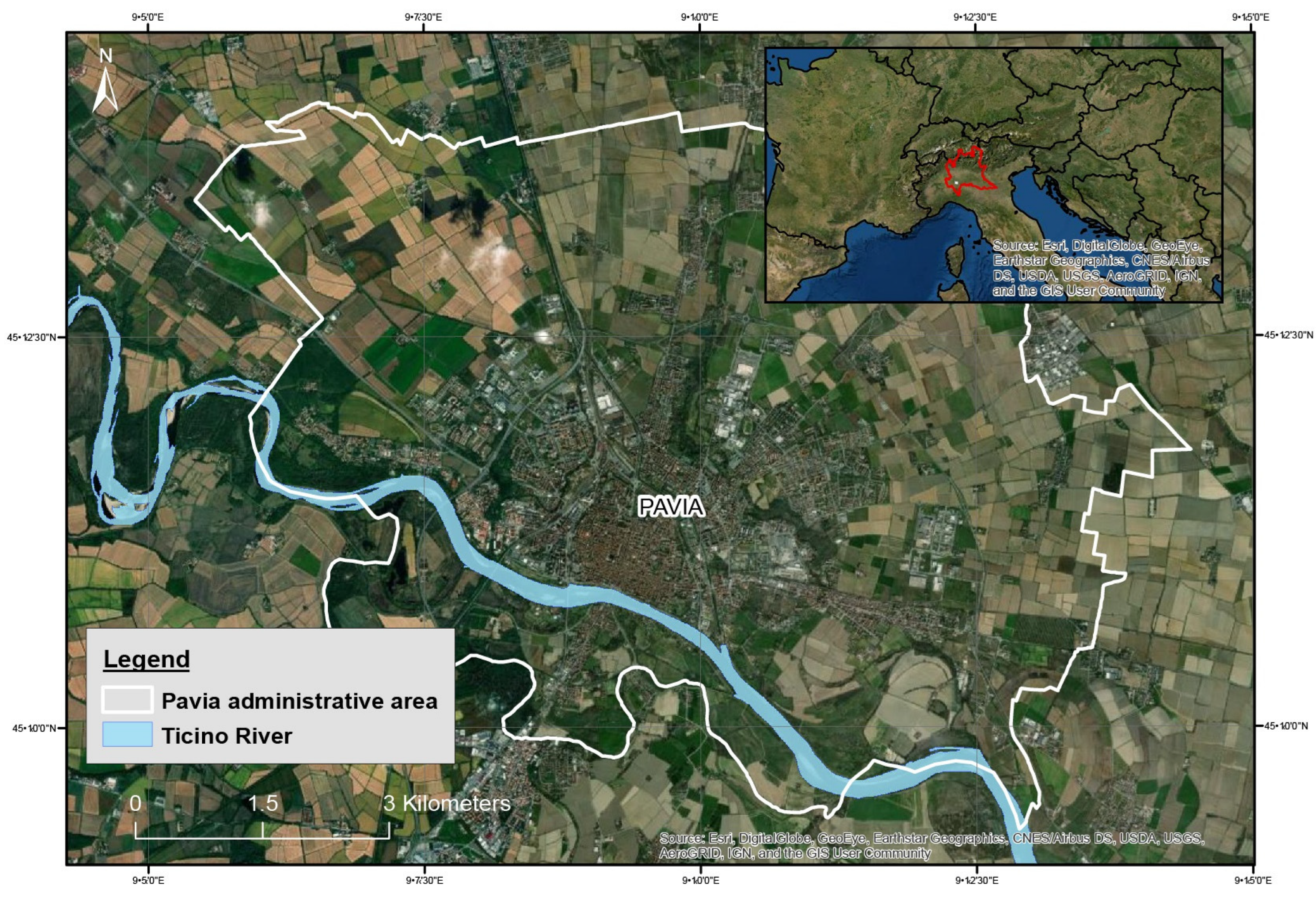
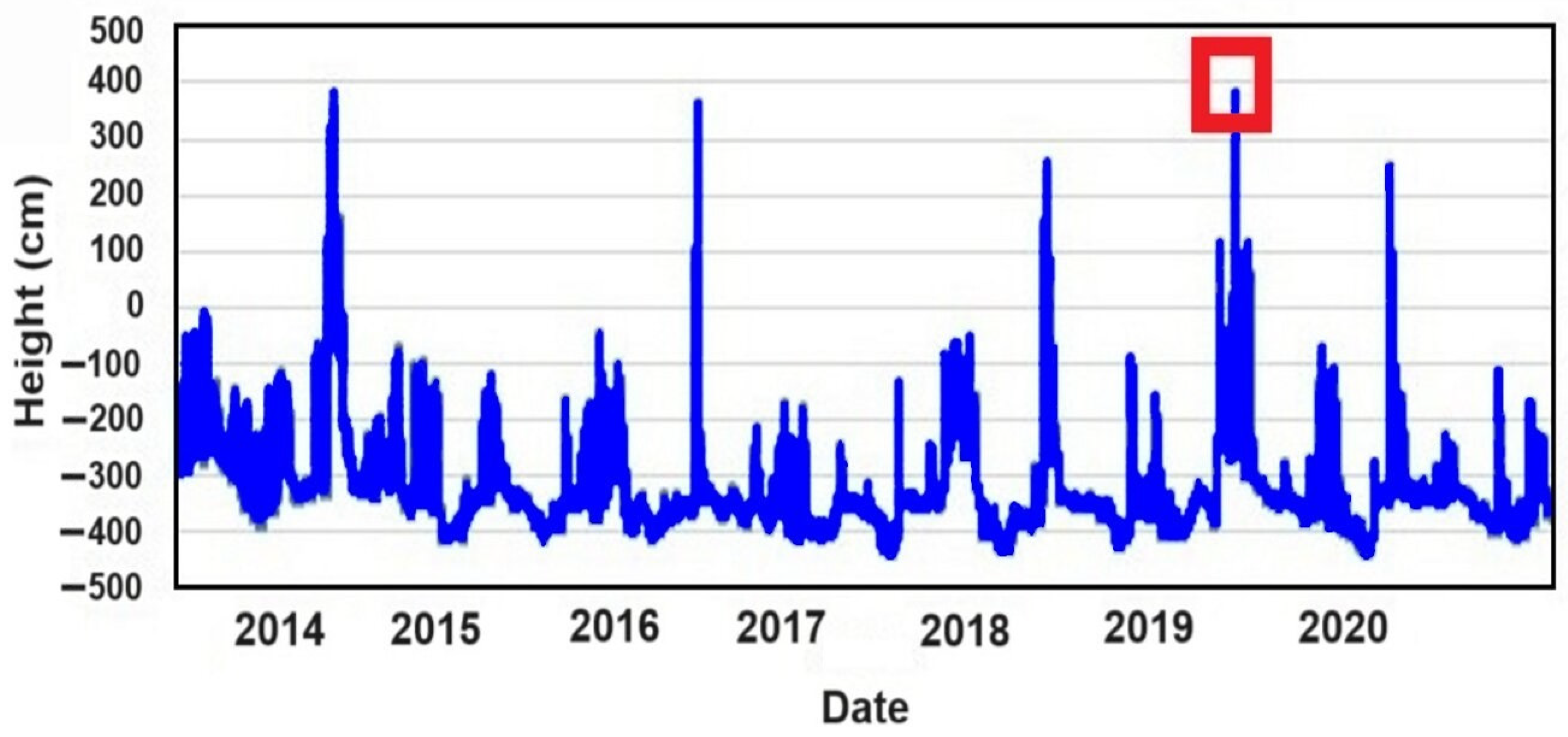
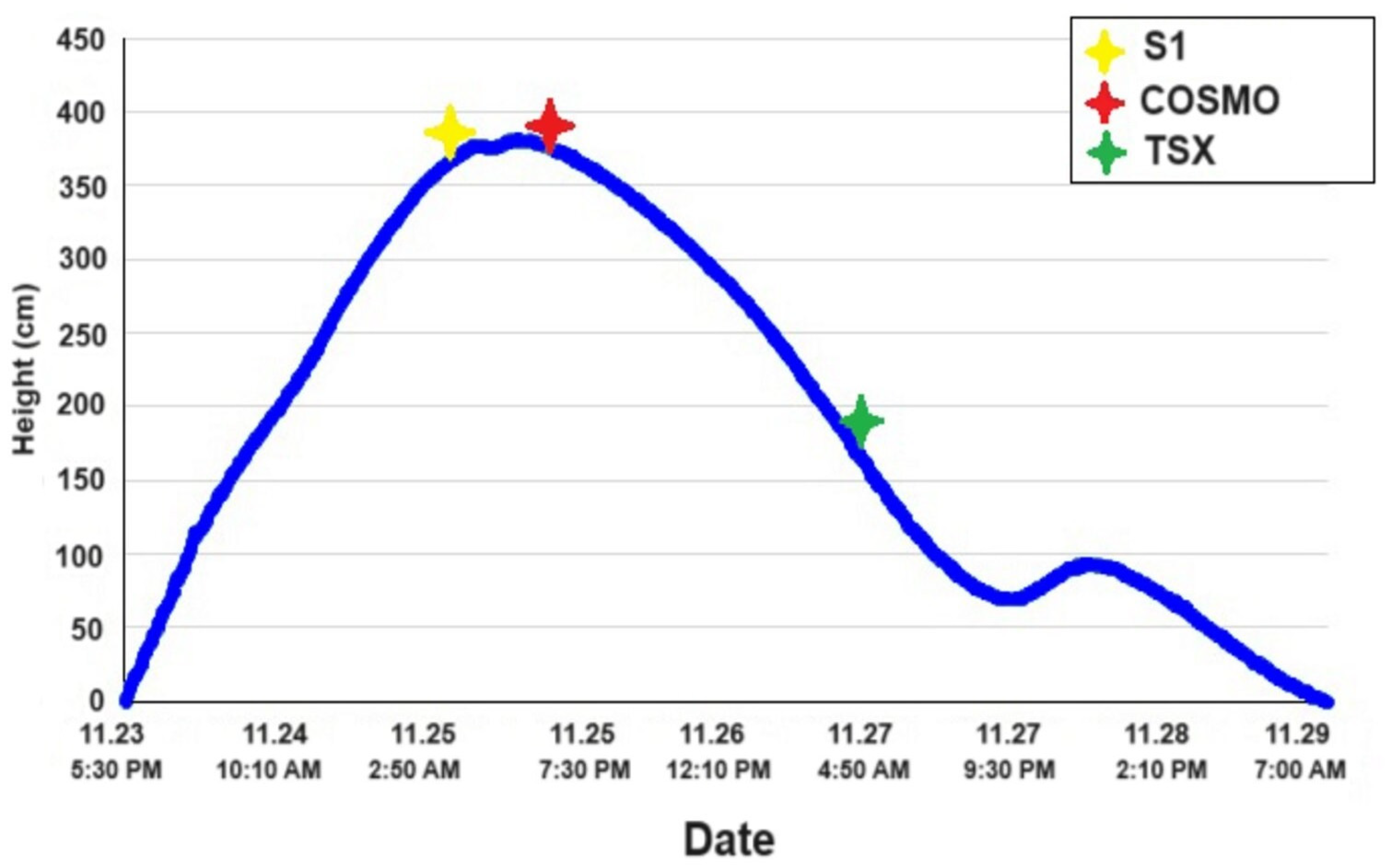

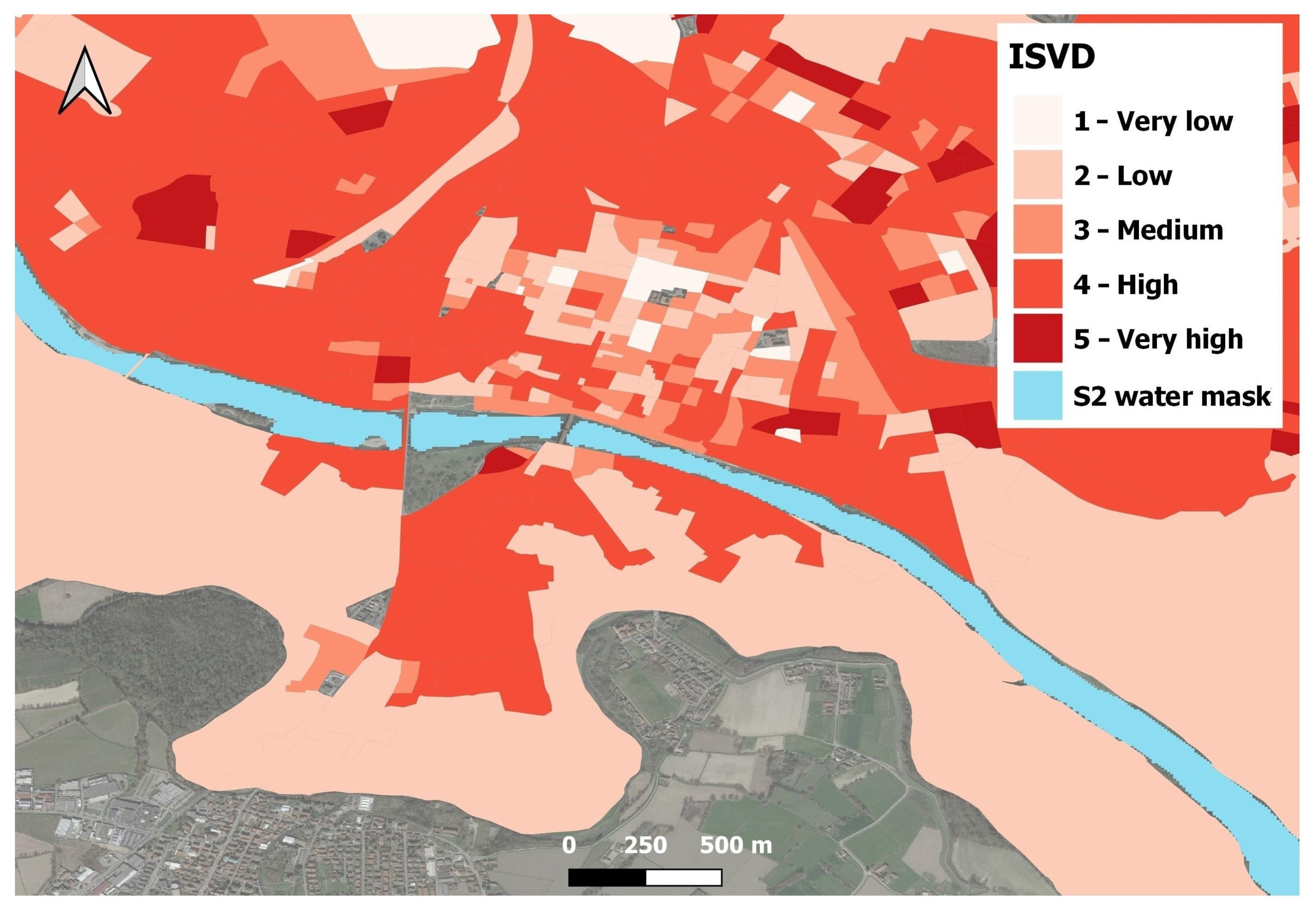
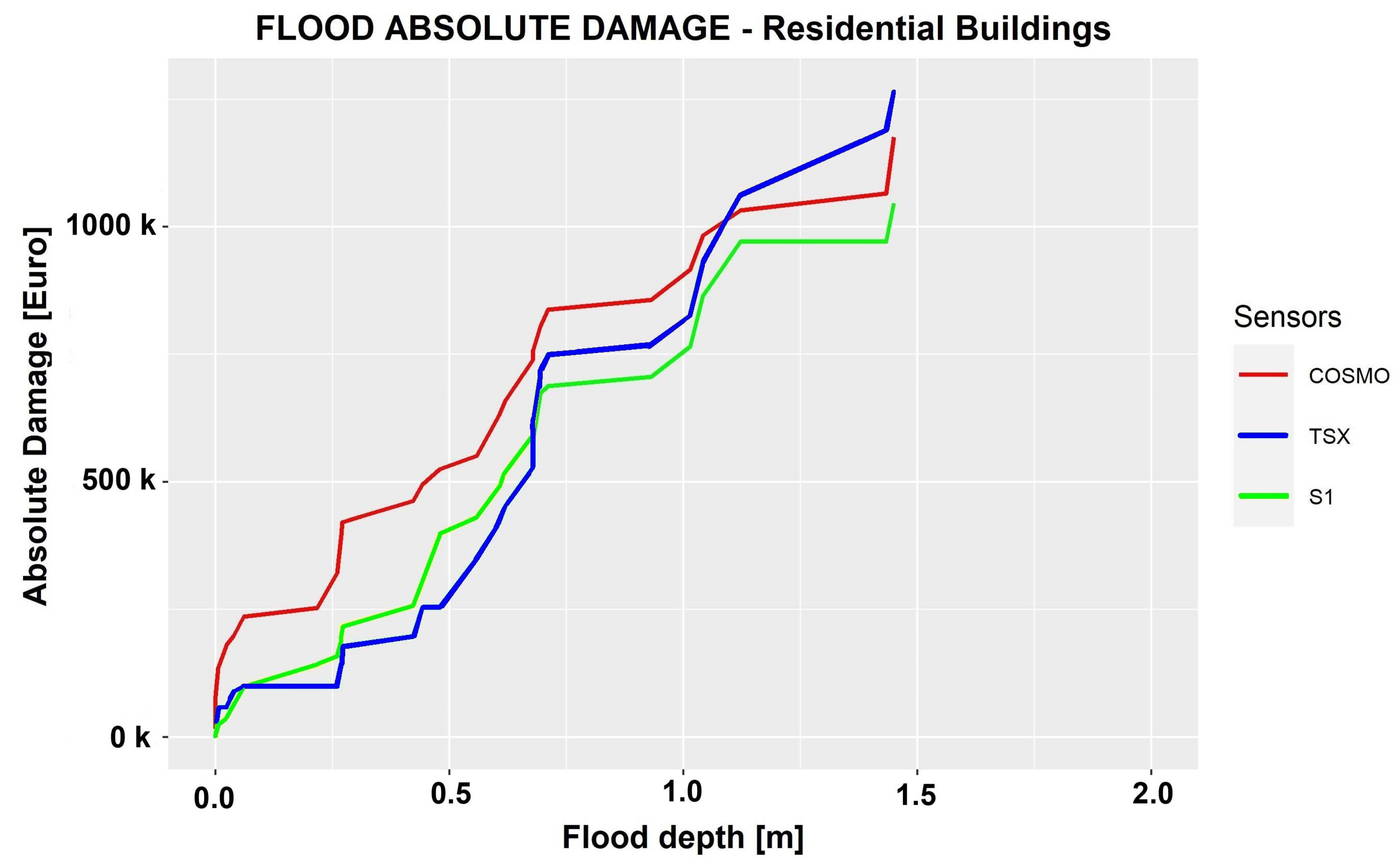
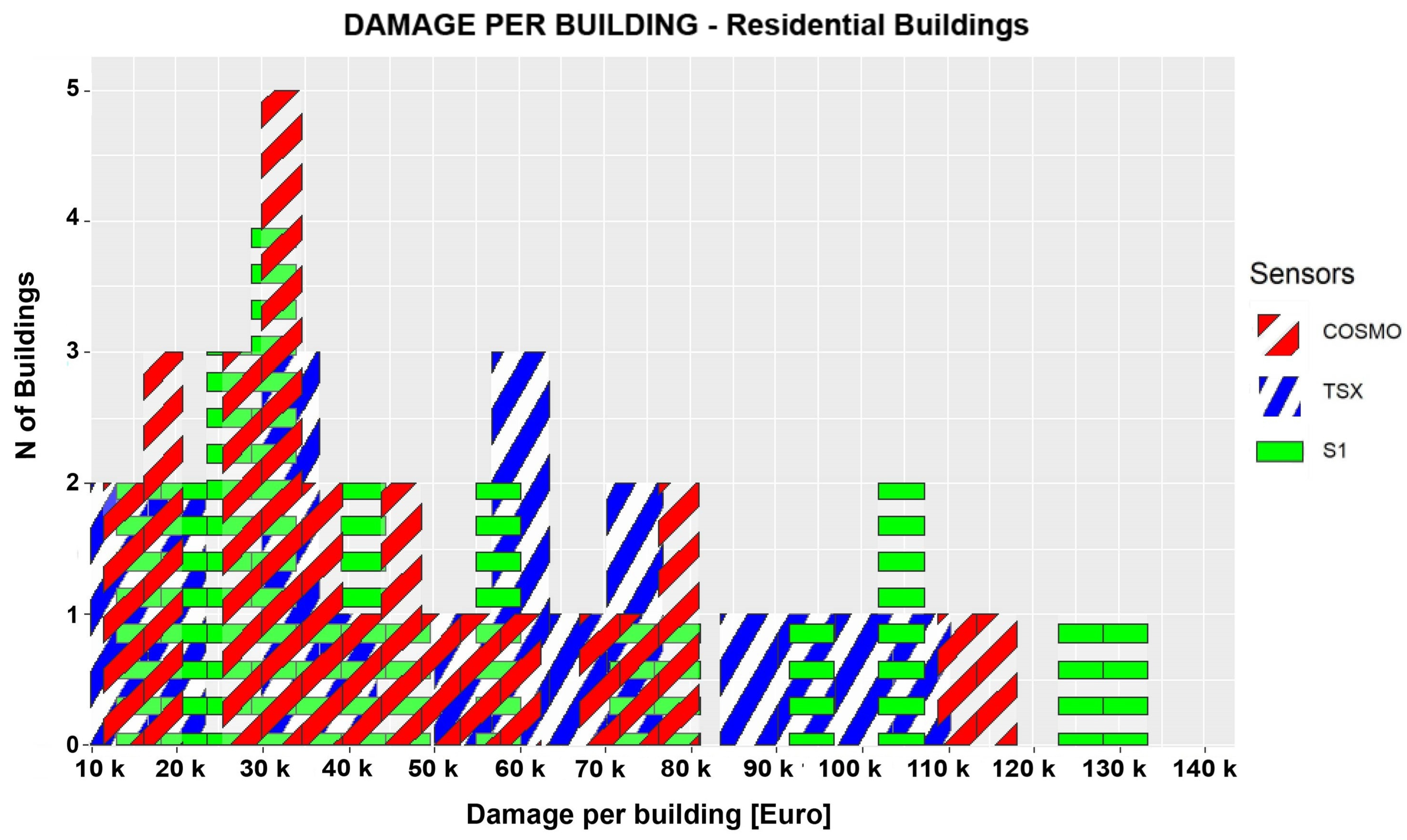
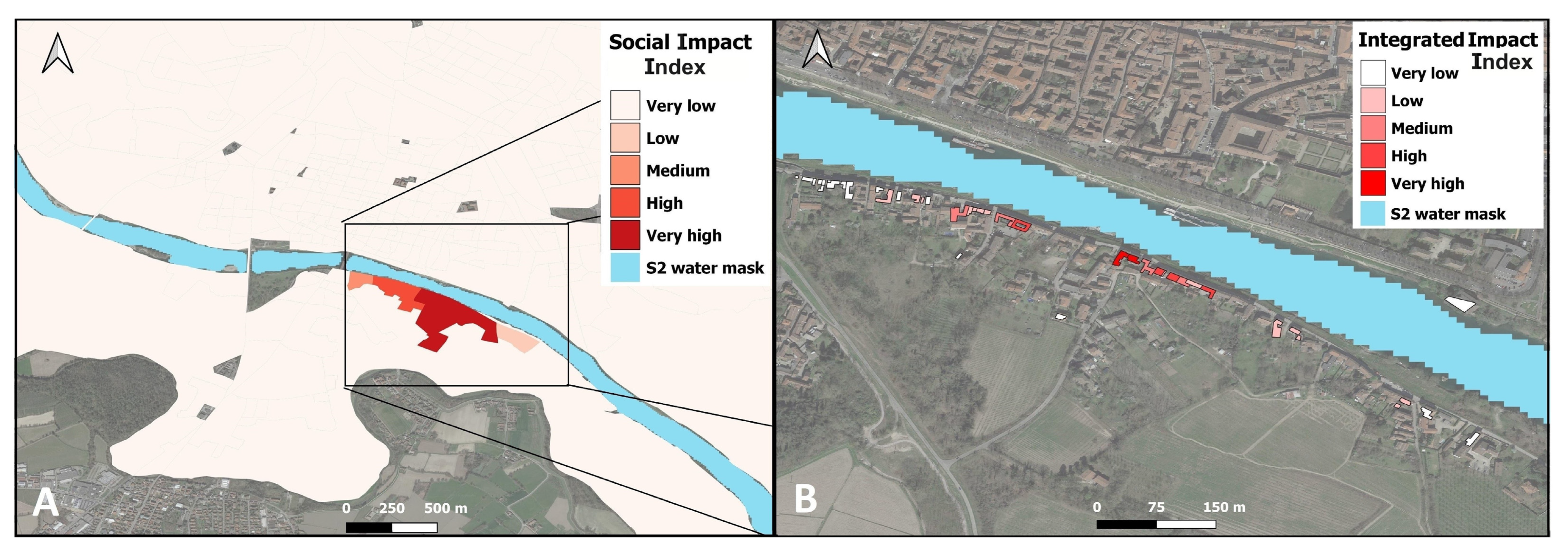
| Value | Level of Importance |
|---|---|
| 1 | Equal importance |
| 3 | Moderate importance |
| 5 | Strong importance |
| 7 | Very strong importance |
| 9 | Extreme importance |
| 2, 4, 6, 8 | Intermediate values |
| 1/3, 1/5, 1/7, 1/9 | Values for inverse comparison |
| INDEX—ABSOLUTE VALUES | ||||||
|---|---|---|---|---|---|---|
| INDEX RELATIVE VALUES | VL | L | M | H | VH | |
| VL | VL, VL | VL, L | VL, M | VL, H | VL, VH | |
| L | L, VL | L, L | L, M | L, H | L, VH | |
| M | M, VL | M, L | M, M | M, H | M, VH | |
| H | H, VL | H, L | H, M | H, H | H, VH | |
| VH | VH, VL | VH, L | VH, M | VH, H | VH, VH | |
| Sensors | COSMO | TerraSar-X | Sentinel 1 |
|---|---|---|---|
| Date (flood) | 25 November 2019 05:20 pm (UTC) | 27 November 2019 05:35 am (UTC) | 25 November 2019 05:34 am (UTC) |
| Date (non-flood) | 29 November 2019 05:26 pm (UTC) | 22 September 2019 05:36 am (UTC) | 26 October 2019 05:34 am (UTC) |
| Band | X | X | C |
| Polarization | HH | HH | VV |
| Acquisition mode | Stripmap | Stripmap | IW |
| Pass | Descending | Descending | Descending |
| Incidence Near 1 Incidence Far 1 | 24.9/28.2 32.4/35.4 | 36.02/35.90 38.61/38.50 | 30.82/30.50 37.04/36.88 |
| Variable | Water Extent (ha) | Water Depth (m) | ||
|---|---|---|---|---|
| Mean | Std. Dev. | Max. | ||
| TSX | 204.8 | 0.13 | 0.29 | 2.02 |
| S1 | 259.3 | 0.13 | 0.29 | 1.92 |
| COSMO | 247.0 | 0.09 | 0.20 | 1.38 |
| Category | COSMO | S1 | TSX | |
|---|---|---|---|---|
| Other | Total population | 125 | 109 | 99 |
| Total buildings | 30 | 24 | 19 | |
| Buildings (m2) | 4149.18 | 3955.17 | 3807.95 | |
| Land use | Impervious area (ha) | 3.34 | 2.62 | 4.59 |
| Permanent crops (ha) | 4.15 | 3.45 | 3.22 | |
| Green urban areas (ha) | 2.03 | 2.25 | 3.10 | |
| Pastures (ha) | 45.94 | 51.69 | 30.37 | |
| Forests (ha) | 69.9 | 70.56 | 39.21 | |
| Arable land (annual crops) (ha) | 112.68 | 110.38 | 103.97 | |
| Total land use (ha) | 238.04 | 240.95 | 184.46 | |
Disclaimer/Publisher’s Note: The statements, opinions and data contained in all publications are solely those of the individual author(s) and contributor(s) and not of MDPI and/or the editor(s). MDPI and/or the editor(s) disclaim responsibility for any injury to people or property resulting from any ideas, methods, instructions or products referred to in the content. |
© 2024 by the authors. Licensee MDPI, Basel, Switzerland. This article is an open access article distributed under the terms and conditions of the Creative Commons Attribution (CC BY) license (https://creativecommons.org/licenses/by/4.0/).
Share and Cite
Righini, M.; Gatti, I.; Taramelli, A.; Arosio, M.; Valentini, E.; Sapio, S.; Schiavon, E. Integrated Flood Impact and Vulnerability Assessment Using a Multi-Sensor Earth Observation Mission with the Perspective of an Operational Service in Lombardy, Italy. Land 2024, 13, 140. https://doi.org/10.3390/land13020140
Righini M, Gatti I, Taramelli A, Arosio M, Valentini E, Sapio S, Schiavon E. Integrated Flood Impact and Vulnerability Assessment Using a Multi-Sensor Earth Observation Mission with the Perspective of an Operational Service in Lombardy, Italy. Land. 2024; 13(2):140. https://doi.org/10.3390/land13020140
Chicago/Turabian StyleRighini, Margherita, Ignacio Gatti, Andrea Taramelli, Marcello Arosio, Emiliana Valentini, Serena Sapio, and Emma Schiavon. 2024. "Integrated Flood Impact and Vulnerability Assessment Using a Multi-Sensor Earth Observation Mission with the Perspective of an Operational Service in Lombardy, Italy" Land 13, no. 2: 140. https://doi.org/10.3390/land13020140
APA StyleRighini, M., Gatti, I., Taramelli, A., Arosio, M., Valentini, E., Sapio, S., & Schiavon, E. (2024). Integrated Flood Impact and Vulnerability Assessment Using a Multi-Sensor Earth Observation Mission with the Perspective of an Operational Service in Lombardy, Italy. Land, 13(2), 140. https://doi.org/10.3390/land13020140







